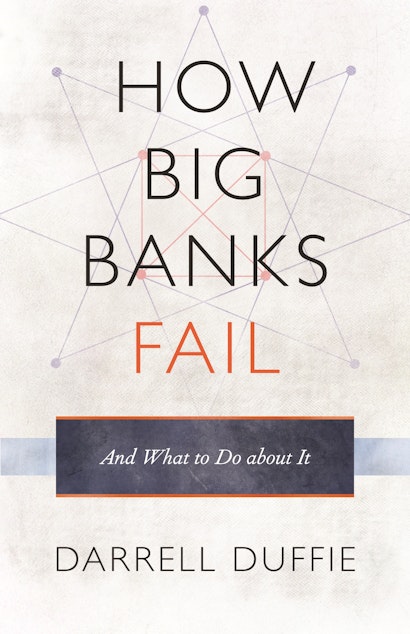Dealer banks—that is, large banks that deal in securities and derivatives, such as J. P. Morgan and Goldman Sachs—are of a size and complexity that sharply distinguish them from typical commercial banks. When they fail, as we saw in the global financial crisis, they pose significant risks to our financial system and the world economy. How Big Banks Fail and What to Do about It examines how these banks collapse and how we can prevent the need to bail them out.
In sharp, clinical detail, Darrell Duffie walks readers step-by-step through the mechanics of large-bank failures. He identifies where the cracks first appear when a dealer bank is weakened by severe trading losses, and demonstrates how the bank’s relationships with its customers and business partners abruptly change when its solvency is threatened. As others seek to reduce their exposure to the dealer bank, the bank is forced to signal its strength by using up its slim stock of remaining liquid capital. Duffie shows how the key mechanisms in a dealer bank’s collapse—such as Lehman Brothers’ failure in 2008—derive from special institutional frameworks and regulations that influence the flight of short-term secured creditors, hedge-fund clients, derivatives counterparties, and most devastatingly, the loss of clearing and settlement services.
How Big Banks Fail and What to Do about It reveals why today’s regulatory and institutional frameworks for mitigating large-bank failures don’t address the special risks to our financial system that are posed by dealer banks, and outlines the improvements in regulations and market institutions that are needed to address these systemic risks.
Darrell Duffie is the Dean Witter Distinguished Professor of Finance at Stanford University's Graduate School of Business. He is the author of Dynamic Asset Pricing Theory and the coauthor of Credit Risk: Pricing, Measurement, and Management (both Princeton).
"This volume will give readers a deeper understanding of how modern banking works."—Choice
"There are precious few manuals on global finance. To be sure, there are enough leaden textbooks and scholarly tomes to crush many a library, but there are few nuts-and-bolts guides. Darrell Duffie has performed a great service by attempting to explain in simple terms why and how major investment banks (what he calls 'dealer banks') collapse. . . . A valuable addition to public literature on the global financial crisis."—Joel Campbell, International Affairs
"This is a clear and readable account of the mechanisms and incentives at play."—Saxon Brettell, Business Economist
"I highly recommend the book. I believe the text should be standard reading for anybody involved with regulating and supervising financial institutions as it offers valuable insights into the plumbing of financial markets and the mechanisms that can cause bank failures. The discussed mechanisms are thought provoking and can provide researchers and regulators with valuable ideas for future research on the financial system as well as banking regulation."—Jan Wrampelmeyer, Financial Markets and Portfolio Management
"In How Big Banks Fail and What to Do about It, Darrell Duffie tackles one of the central but often neglected issues in building a more resilient financial system. Duffie has that rare combination—the rigor of the academy and knowledge of how the plumbing of the financial system works. Anyone interested in regulatory reform will need to engage with his thinking."—Paul Tucker, deputy governor, financial stability, Bank of England
"The book does an excellent job of explaining the institutional setting of big dealer banks and how things went wrong in the financial crisis. The issues are important and the policy suggestions sound. There is nothing quite like this out there."—Franklin Allen, University of Pennsylvania
"Darrell Duffie is one of the leading experts on the problem of large-bank failures. He focuses on issues not addressed elsewhere, but which are being talked about everywhere. This book scores in a big way."—Viral V. Acharya, New York University


